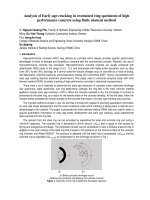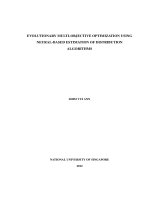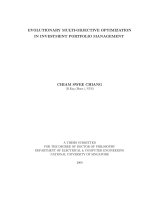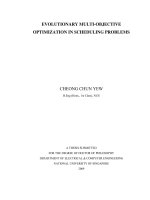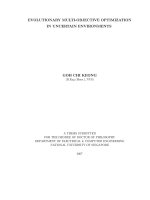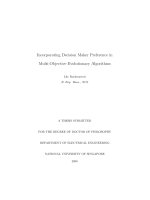High performance concrete mixture proportioning: Multi objective optimization approach
Bạn đang xem bản rút gọn của tài liệu. Xem và tải ngay bản đầy đủ của tài liệu tại đây (771.27 KB, 12 trang )
Journal of Science Ho Chi Minh City Open University – VOL. 20 (4) 2016 – December/2016 65
HIGH PERFORMANCE CONCRETE MIXTURE PROPORTIONING:
MULTI-OBJECTIVE OPTIMIZATION APPROACH
NGUYEN VIET DUC
Industrial University of Ho Chi Minh City, Vietnam –Email:
DANG HOANG MINH
Industrial University of Ho Chi Minh City, Vietnam – Email:
(Received: September 09, 2016; Revised: October 26, 2016; Accepted: December 06, 2016)
ABSTRACT
This paper presents the application of multi-objective optimization approach to high performance concrete
mixture proportioning. An integrated mathematical model was developed in order to optimize six criteria, which are
the chlorine ion diffusion coefficient, per cubic meter cost, the amount of cement, fly ash, slag, chemical admixture.
This model needs to satisfy with ten functional constraints and seven design variables. The Visual Interactive
Analysis Method (VIAM) was used to solve the multicriteria task. Eventually, twelve solutions have been found for
the different cases in terms of criteria during the process of proportioning high performance concrete mixture. They
are all Pareto solutions, which allow experts to choose in the proposed cases.
Keywords: High performance concrete; mix proportion; multi-objective optimization; Pareto solution; Visual
Interactive Analysis Method; VIAM.
1. Introduction
The parts of the world in which largescale concrete construction takes place have
extended enormously. Due to the recent trends
in construction industries (i.e., increased
number of heavily reinforced concrete
structures), construction of large and taller
structures, and developments of construction
techniques (i.e., efficient concrete pumping
techniques), the industries and companies in
general strive to cast massive volume of
concrete. When this large volume of concrete
is used for construction, the safety and
durability of cast concrete become
fundamental issues. To ensure these issues,
much effort has been focused on the
developments of high-performance concrete
(Neville and Aitcin, 1998).
High-performance concrete is designed to
give optimized performance characteristics for
a given set of materials, usage, and exposure
conditions,
consistent
with
strength,
workability, service life, and durability.
Engineers and constructors all over the world
are finding that using high performance
concrete allows them to build more
serviceable structures at comparable cost.
High-performance concrete is being used for
structures in aggressive environments: marine
structures, highway bridges and pavements,
nuclear structures, tunnels, precast units, etc.
(Aitcin, 2000).
Meanwhile, in Vietnam in recent years,
high-performance concrete has played an
important role in the engineering structures
like bridges, roads, high-rise buildings in the
big cities (Hanoi, Ho. Ho Chi Minh City, Da
Nang). Especially, in the construction of
reinforced concrete bridge and tunnel by new
technology high-performance concrete was
used properly, such as intersections at Chuong
Duong Bridge in Hanoi, Hai Van tunnel in Da
Nang or Thu Thiem tunnel in Ho Chi Minh
(Pham, 2008).
The
major
difference
between
conventional concrete and high-performance
concrete is essentially the use of chemical and
mineral admixtures. The use of chemical
admixtures reduces the water content, thereby
at the same time reduces the porosity within
66 High performance concrete mixture proportioning: Multi-objective optimization approach
the hydrated cement paste. The reduction in
the water content to a very low value with
high dosage of chemical admixtures is
undesirable, and the effectiveness of chemical
admixtures
such
as
superplasticizer
principally depends on the ambient
temperature, cement chemistry, and fineness.
Mineral admixtures, also called as cement
replacement materials, act as pozzolanic
materials as well as fine fillers; thereby, the
microstructure of hardened cement matrix
becomes denser and stronger. At ambient
temperature, their chemical reaction with
calcium hydroxide is generally slow.
However, the finer and more vitreous the
pozzolan is, the faster will be this reaction. If
durability is of primary interest, then the slow
rate of setting and hardening associated with
the incorporation of fly ash or slag in concrete
is advantageous. Also, the mineral admixtures
are generally industrial by-products and their
use can provide a major economic benefit.
Therefore,
the
combined
use
of
superplasticizer and cement replacement
materials can lead to economical highperformance concrete with enhanced strength,
workability, and durability. It is also reported
that the concrete containing cement
replacement materials typically provides
lower permeability, reduced heat of hydration,
reduced alkali–aggregate reaction, higher
strength at later ages, and increased resistance
to attack from sulfates. However, the effect of
cement replacement materials on the
performance of concrete varies markedly with
their properties (Hassan et al. 2000). To
obtain the special combinations of
performance and uniformity requirements, a
near-optimum mix proportion of highperformance concrete is very important.
In this paper, high-performance concrete
of class 60 MPa is a selected object used for
the multi-objective optimization. The
constituent materials of this concrete are
Portland cement, water, fly ash, fine slag,
sand, stone and chemical admixture, as
illustrated in Figure 1. The costly materials
such as cement, slag, fly ash and admixture,
cost of 1m3 concrete, and diffusion factor,
which represents concrete durability are the
objective functions. The optimal solution for
mix proportion should be a concrete with low
costly materials content, low diffusivity and
low total cost of 1m3 concrete.
Figure 1. Concrete constituent materials for high-performance concrete
2. Problem statement
The literature review has revealed that in
Xie's work (Xie et al., 2011), a mathematical
model for multi-objective optimization of
concrete mix has been established. However,
these authors only have considered two
criteria such as the chlorine ion diffusion
coefficient and cost of 1m3. In fact, the
amounts of costly components like Portland
cement, fly ash, slag and, chemical
Journal of Science Ho Chi Minh City Open University – VOL. 20 (4) 2016 – December/2016 67
admixtures, which are also criteria in
objective function, need to be minimized
when designing a concrete mix. Therefore, in
this paper, an integrated mathematical model
was developed for multicriteria design of high
performance concrete, which is better adapted
to the production process in real conditions in
Vietnam. Therefore, the cost of constitutent
materials, which is considered in this paper,
was taken at the current circumstance at the
area of Ho Chi Minh City.
Mathematical model of the problem in
this paper are presented in the diagram below
(Figure 2).
Figure 2. Model for multicriteria design of high performance concrete mix
In this model, three factors are variables,
constraints and criteria, which are stated as follows:
Design variable
The control variables and their
corresponding contraints in the mathematical
model are included in Table 1.
Table 1
Design variables and their constraint
Design
variable
Meaning: Amount of
materials
Units
Initial lower
admissible value
Initial upper
admissible value
x1
Portland cement
kg/m3
300
500
x2
Water
kg/m3
130
210
x3
Fly ash
kg/m3
45
155
x4
Fine slag
kg/m3
60
200
68 High performance concrete mixture proportioning: Multi-objective optimization approach
Design
variable
Meaning: Amount of
materials
Units
Initial lower
admissible value
Initial upper
admissible value
x5
Sand
kg/m3
500
1000
x6
Stone
kg/m3
900
1400
x7
Chemical Admixtures
kg/m3
2.5
12
Functional constraints
The functional constraints are given by the following equality and inequalities (see Table 2).
Table 2
Functional constraints
Function
Expression
Type of
constraint
x2
0.2
x1 x3 x4
≤0
f2
x2
0.4
x1 x3 x4
≤0
f3
x5
0.35
x5 x6
≤0
f4
x5
0.4
x5 x6
≤0
f5
450 x1 x3 x4
≤0
f6
x1 x3 x4 600
≤0
x7
0.01
x1 x3 x4
≤0
f1
f7
f8
f9
x7
0.02
x1 x3 x4
7
i 1
f10
xi
990
≤0
The range of water to binder ratio
The range of sand ratio, which is the
ratio of the amount of sand to the
amount of overall aggregates
The range of the amount of
cementitious
material
including
cement, fly ash and slag.
The High–Range Water–Reducing
Admixture (HRWRA) is used to
improve the workability and microstructure of concrete. These are its
ratio to cement
=0
The volume of concrete mixture is
made up of the absolute volume of
each content and the volume of the air
captured in the mixture. The
following expression should be met
for the amount of materials for each
cubic meter of concrete mixture
≤0
The strength of concrete, which is
affected by various factors, is the
most important parameter in concrete
design
i
x x x
0.304c f ce,k 1 3 4 0.62
x2
f cu ,k t
Meaning
Journal of Science Ho Chi Minh City Open University – VOL. 20 (4) 2016 – December/2016 69
where ρi (i = 1..7) represents the density
of each ingredient (ton/m3): ρ1 = 3.11; ρ2 = 1;
ρ3 = 2.11; ρ4 = 2.45; ρ5 = 2.61; ρ6 = 2.76; ρ7
= 1.08. λc is the affluence coefficient of the
strength class of concrete. It should be
determined according to statistics and in
general cases it can be 1.13; fce,k represents the
grading strength of cement and fce,k = 50.5;
fcu,k is the standard value of compressive
strength of concrete and fcu,k = 68; t is the
degree of probability and t = –1.64; σ is the
standard deviation of concrete strength. It is
determined according to the national standard
code for acceptance of constructional quality
of concrete structure and σ = 5 (Pham, 2008).
Performance criteria
The performance criteria are shown in
Table 3:
Table 3
Performance criteria
Criteria
Expression
Ф1
x2
0.45 0.2
MIN 5.760 5.81
x1 x3 x4
0.567 x1 x3 x4 425 175 1.323
x3
0.74
100 22.5 22.5
x1 x3 x4
Meaning
The chlorine ion diffusion
coefficient on the 28th day for
concrete without microsilica
under a molding temperature of
21 Celsius degree.
(m2/s)
x4
2.117
100 35 35
x1 x3 x4
2.78 0.472 0.254 0.286 0.368 1
x3
x2
0.45
100 22.5
x1 x3 x4
x1 x3 x4
1.171
0.2
22.5
x2
0.45
x1 x3 x4
2.891
0.472
0.2
2
x3
100 22.5
x1 x3 x4
1.053
0.472
22.5
106
365 24 3600
Ф2
MIN
y x
Ф3
MIN
Ф4
MIN
Ф5
MIN
Ф6
MIN
x1
7
i 1
i
x3
x4
x7
Per cubic meter cost (VND/m3)
i
Amount of Portland cement per
cubic meter (kg/m3)
Amount of Fly ash per cubic
meter (kg/m3)
Amount of Fine slag per cubic
meter (kg/m3)
Amount of Chemical Admixtures
per cubic meter (kg/m3)
70 High performance concrete mixture proportioning: Multi-objective optimization approach
where yi (i = 1..7) the unit price of each
ingredient (VND/kg): y1 = 1500; y2 = 12; y3 =
550; y4 = 5050; y5 = 118; y6 = 135; y7 = 21000.
In this mathematical model, we need to
optimize 6 standard criteria Фi (i = 1..6),
which are necessary to satisfy with 10
functional constraints and 7 design variables
xk (k = 1..7).
3. Method of solution and calculation
In recent years, the single-objective and
multi-objective optimization methods have
been used commonly. However, most of the
preceding studies have focused on the
development of optimization algorithms for a
single-objective function. The problem of a
multicriteria task most of the time was
converted into a representative single criteria
by means of the methods, for instance,
Weighted Minimax (Maximin), Compromise
Programming, Weighted Sum, Bounded
Objective Function, Modified Tchebycheff,
Weighted Product, Exponential Weighted
Sum, etc.
Xie and colluegues (Xie et al., 2011) have
also chosen that option. After proposing an
equivalent objective function, those authors
used the method of Sequencial Quadratic
Programming to find out the minimum. It is
important to note that there are many methods
to find the minimum of an equivalent
function, such as algoritms Cooko, Fireflies,
Hybrid, Genetic, Swarm, ect. Every algoritm
gives the minimum with a small discrepancy.
However, the problem is that the solution of
the equivalent function does not represent the
solution of the individual function. This
means that one criteria reaches the optimum
by using a certain algoritm, but another
criteria does not reach the optimum by using
another algoritm.
There are two questions that have not
been reviewed in detail in the abovementioned
work applied to a single-objective function:
Will the equivalent criteria be able to
actually substitute for the individual analysis
of single criteria, when importance grade of
every single criteria at certain moment and
production circumstance is different from one
expert to another?
In the course of preparation and real
production process, how will the experts be
able to analyze directly, and opt for the
priority consideration of criteria flexibly,
which in turn make an appropriate desicion?
The significane of the optimization
algorithm is enormous, however in practice
when a flexible compromise needs to be made
to find out the most feasible production
option, the criteria should be analyzed
individually and repeatly in comparative
process. Then the “give and take” process
should be done in order to achieve an
aggrement among the criteria. Therefore, it is
necessary to have a tool or an approach to
solve a multicriteria task with high
applicability. In this paper, an application of
Visual Interactive Analysis Method (VIAM)
is proposed to tackle with the issue of high
performance concrete mixture proportioning.
The VIAM was described in details,
elsewhere (Gavriushin and Dang, 2016). The
main idea of this method includes: i) set up an
interactive table, containing the range value of
criteria, which satisfies with all contraints; ii)
based on the current circumstance and
determined production demand, the experts
would give the threshold values of the criteria
(the threshold is within the range value); iii)
the final step is to find the variable vector,
which satisfy with the threshold values.
There are many ways to find a valid
variable vector. VIAM uses two main
approaches; such as filling and spatial
parameter survey, and space conversion
variables - functional constraints - criteria. In
this paper, the authors will take into account
the second approach. The process to solve the
mathematical task is presented below.
Determination of the range value of
criteria and set it up in the interactive table.
Using an available single-objective
optimization method, we can find the
minimum of the objective function and the
interactive table is presented as follows:
Journal of Science Ho Chi Minh City Open University – VOL. 20 (4) 2016 – December/2016 71
Table 4
The Interactive Table
minФ1 =
0
minФ2 =
1.1x106
minФ3 =
300
minФ4 =
45
minФ5 =
60
minФ6 =
4.5
…
…
…
…
…
…
[Ф1]
[Ф2]
[Ф3]
[Ф4]
[Ф5]
[Ф6]
…
…
…
…
…
…
maxФ1 =
5.78x10-13
maxФ2 =
2.04x106
maxФ3 =
495
maxФ4 =
155
maxФ5 =
200
maxФ5 =
12
The chlorine ion
diffusion
coefficient (m2/s)
Per cubic
meter cost
(VND/m3)
Amount of
Portland
cement
(kg/m3)
Amount of
Fly ash
(kg/m3)
Amount of
Fine slag
(kg/m3)
Amount of
Chemical
Admixtures
(kg/m3)
When using the interactive table in the
production process, there are many different
cases and the corresponding production
methods. In this paper, three production cases
are solved by using VIAM.
Case 1: there is a hypothesis that the
experts have discussed and indicated the
required threshold value of criteria, as
included in Table 5:
Table 5
Case 1
Ф2
Ф3
Ф1
Ф5
Ф4
Ф6 ■
1.3 x 106
400
4.5 x 10-13
100
100
8
First of all, we have minФ2, and it has
2
been set before that min 2 1.3 10 .
Since this threshold is within the range valur
of Ф2, there exist definitely satisfied variable
vectors. Three of those vectors are represented
6
in the matrix form in Figure 3. In the first
row, there are 7 variables, in the second row
there are functional constraints and in the last
row they are criteria values.
(1)
(2)
(3)
Figure 3. Obtained solution 2 min 2 1.3 106
72 High performance concrete mixture proportioning: Multi-objective optimization approach
The solutions (1) – (3) satisfy the criteria
2, 3, 5, and 6. However, only the solution (2)
satisfies the criteria 1, but does not for the
criteria 4 from the expert’s point of view.
Although the solutions (1) and (3) do not
satisfy the criteria 1, they excel for the criteria
4. Therefore, only the solution (3) satisfies all
of criteria from the expert’s standpoint.
Nevertheless, the value of criteria 1 is
4.43x10-13, which is very close to 4.5x10-13 or
it is not really optimized. Additionally, it is
still unknown what the optimum value of
criteria 2 can be reached, when compromising
that the criteria 2 is the most important one.
Thus, let’s move to the next step.
Adding to the constraints the condition
2 2 2 106 to find minФ3. We
obtain the following three results, as shown in
Figure 4:
(4)
(5)
(6)
Figure 4. Obtained solutions 2 min 2 1.3 106 và 3 400
Three solutions (4) – (6) satisfy the criteria
1, 2, 3, 5, and 6. Particularly, the criteria 1, 3,
5, and 6 excel the purposes of the experts.
However, these solutions do not satisfy the
criteria 4, because all of them are out of
allowable limits according to the experts.
Besides, for the criteria 3 the minimum value
3 305 can be obtained. Nevertheless, there
is still no solution satisfying all of requirements
from the experts at this step.
Adding to the constraints the condition
3 3 3 106 to find minФ1. We obtain
the following three results, as shown in Figure 5:
(7)
(8)
(9)
Figure 5. Obtained solution 2 min 2 1.3 106 , 3 400 , 1 4.5 1013
Journal of Science Ho Chi Minh City Open University – VOL. 20 (4) 2016 – December/2016 73
Three solutions (7) – (9) satisfy the
criteria 1, 2, 3, and 5. Looking at the criteria 5
and 6 for the solutions (7) – (9), they are
opposite. At this moment, the solution (9)
seems to be satisfied all of requirements from
the experts. In principle, we can stop the work
at
this
step.
However,
if
more
13
severely 1 3.022 10
is set for the
criteria 1, we do not have any satisfied
solution, because the solutions (7) and (8) do
not satisfy the criteria 4. Thus, let’s carry on
the next step.
Adding to the constraints the condition
1 1 1 106 to find minФ5. We obtain
the following four results, as shown in Figure 5:
(10)
(11)
(12)
(13)
Figure 6. Obtained solutions 2 min 2 1.3 106 , 3 400 , 1 4.5 1013 , 5 100
The minimum value of criteria 5, which
can be reached after passing the system of 10
functional constraints, is 64 (at solution (10)).
However, these solutions do not satisfy the
criteria 4, thus we need to look into the criteria
4 at this step. At the moment, there is still no
satisfied solution. Nevertheless, if select the
threshold value of the criteria 4 according to the
solutions (10) and (11), the criteria will be
rarely satisfied. Thus, we opt for 5 80 .
Adding to the constraints the condition
5 5 5 106 to find minФ4. We obtain the
following three results, as shown in Figure 7:
(14)
(15)
(16)
Figure 7. Obtained solutions 2 min 2 1.3 106 , 3 400 , 1 4.5 1013 , 5 100 , 4 100
74 High performance concrete mixture proportioning: Multi-objective optimization approach
All of solutions (14), (15), (16) satisfy all
of the criteria requirements, therefore they are
satisfied solutions. However, we need to
analyze whether the criteria 6 can be
optimized more. Looking into the criteria (4),
(5), (6) of the solutions (15) and (16), the
minimum value of the criteria 4 does not
worsen the value of criteria 6, and only
influences on the value of criteria 5, besides it
is within the allowable limits. Thus, we opt
for 4 76.
Adding to the constraints the condition
4 4 4 106 to find minФ6. We
obtain the following two results, as shown in
Figure 8:
(17)
(18)
2
Figure 8. Obtained solutions min 2 1.3 10 ,
6
3 400 , 1 4.5 1013 , 5 100 , 4 100 , 6 8
For the criteria 6, the solutions (17) and
(18) do not turn out the significant
optimization in comparison with the solution
(14)-(16). However, they all satisfy the
requirements from the experts included in
Table 5. Therefore, for the case 1 we have 7
satisfied solution, those are solutions (3), (9),
(14) – (18), all of them are Pareto solutions,
which are not able to be optimized
simultenously at all of criteria.
Case 2: the experts focus on the three
criteria, which have a similar importance. The
experts do not allow lowering the limit value
of the criteria, as included in Table 6.
Table 6
Case 2
[Ф1]
[Ф2]
[Ф3]
-13
6
1.8 x 10
1.3 x 10
390
We add to the constraints three conditions
minФ1 ≤ ФX1 ≤ [Ф1], minФ2 ≤ ФX2 ≤ [Ф2],
minФ3 ≤ ФX3 ≤ [Ф3] to find the minimum
value of the function
min F min 1 X1 2 X2 3 X3 0 .
We obtained the following two results, as
shown in Figure 9.
(19)
(20)
Figure 9. Obtained solution in accordance with Table 6
Journal of Science Ho Chi Minh City Open University – VOL. 20 (4) 2016 – December/2016 75
The solution (20) is more optimized than
the solution (19) at most of criteria, but it is
only less at the criteria 5. However, the
experts can estimate the importance of criteria
5 in comparison with the other 5 criteria to
choose the solution (19) or (20). These two
solutions excel the purpose of the experts at
the criteria 3.
Case 3: the experts estimate the threshold
value of all of criteria, as present in Table 7.
The requirement is to the vector suitable for
all of the criteria simultenously.
Table 7
Case 3
[Ф1]
[Ф2]
[Ф3]
[Ф4]
[Ф5]
[Ф6]
2 x 10-13
1.4 x 106
400
110
140
8
Similarly to the case 2, we add to the constraints six conditions minФ1 ≤ ФX1 ≤ [Ф1], minФ2
≤ ФX2 ≤ [Ф2], minФ3 ≤ ФX3 ≤ [Ф3], minФ4 ≤ ФX4 ≤ [Ф4], minФ5 ≤ ФX5 ≤ [Ф5], minФ6 ≤ ФX6
6
≤ [Ф6] to find the minimum vale of function min F min
i Xi 0 . We obtain the
i 1
following three results, as shown in Figure 10.
(21)
(22)
(23)
Figure 10. Obtained solution in accordance with Table 7
These solutions are Pareto solutions,
because there are superior and inferior criteria
when comparing one to another. The values of
criteria at these solutions are much better than
the requirements of the experts included in
Table 7.
4. Concluding remarks
It is important to note that the solution for
multi-objective optimization task applied to
high
performance
concrete
mixture
proportioning is not unique. Because, the
solution is a set of criteria values, but every
criteria has a different importance from one
expert’s standpoint to another at the certain
production circumstance. Therefore, the
evaluation of one solution or another based on
an equivalent function for all of criteria is not
comprehensive.
Above all, 12 solutions have been found
for the different cases in terms of criteria
during the process of proportioning high
performance concrete mixture. They are all
Pareto solutions, which allow experts to
choose in the proposed cases. The task can
76 High performance concrete mixture proportioning: Multi-objective optimization approach
also be extended with more variables,
constraints, criteria when varying the amount,
as well as the constituent material to make
high performance concrete. Last but not least,
the multi-objective optimization would
definitely provide an optimum solution for
high performance concrete mix propotioning
with high durability and reasonable cost
References
Aitcin, P.C. (2000). Cements of yesterday and today: Concrete of tomorrow. Cement and Concrete Research 30 (9),
1349–1359.
Gavriushin, S.S. and Dang, M. (2016). Multicriteria management of the metal cutting process. Journal of higher
educational institutions: Machine building,10,82-95.
Hassan, K.E., Cabrera, J.G., Maliehe, R.S. (2000). The effect of mineral admixtures on the properties of highperformance concrete. Cement and Concrete Composites, 22 (4), 267–271.
Neville, A.M. and Aitcin, P.C. (1998). High-performance concrete - An overview. Materials and Structures, 31 (3),
111 – 117.
Pham, D. H. (2008). Bê tông cường độ cao và chất lượng cao. Hà Nội: NXB Xây Dựng.
Xie, X., Zheng, Y., Tian, F. (2011). Multi-objective Optimized Design of High-Performance concrete Based on
Matlab. Advanced Materials Research, 261-263, 202-207.
